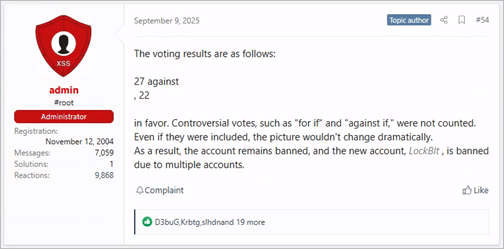After months of disruption following Operation Cronos in early 2024, the notorious LockBit ransomware group has resurfaced with renewed vigor and a formidable new arsenal.
In September 2025 alone, researchers identified a dozen organizations targeted by the revived operation.
Particularly alarming is the rapid adoption of the new LockBit 5.0 variant, which accounted for half of the identified attacks during the month. The victims span Western Europe, the Americas, and Asia, demonstrating LockBit’s global reach and the reactivation of its extensive affiliate network.
Check Point Research has confirmed that LockBit is actively extorting organizations across multiple continents, with the freshly launched LockBit 5.0 variant—internally designated “ChuongDong”—already establishing itself as a significant threat to enterprises worldwide.
LockBit’s comeback was anything but subtle. At the beginning of September, the group’s administrator, LockBitSupp, officially announced the operation’s return on underground forums while simultaneously recruiting new affiliates.
This announcement came after months of increasingly confident messaging on dark web platforms. In May 2025, LockBitSupp posted defiantly on the RAMP forum: “We always rise up after being hacked.” By August, he reiterated that the group was “getting back to work”—a claim that September’s wave of infections swiftly validated.


The speed of LockBit’s operational recovery highlights a critical vulnerability in the ransomware landscape: even sophisticated law enforcement disruption campaigns struggle to permanently dismantle well-established RaaS ecosystems.
LockBit’s mature infrastructure, proven reputation among cybercriminals, and experienced affiliate base enabled rapid reconstruction despite the earlier takedown.
Technical Evolution and Multi-Platform Targeting
LockBit 5.0 introduces several significant technical enhancements designed to maximize impact while minimizing detection windows.
The new variant now supports Windows, Linux, and ESXi environments—a critical expansion that enables attackers to compromise hybrid and virtualized infrastructure simultaneously. Approximately 80% of observed attacks targeted Windows systems, while roughly 20% focused on ESXi and Linux environments.
Additional improvements in LockBit 5.0 include stronger anti-analysis mechanisms that obstruct forensic investigations, optimized encryption routines that dramatically reduce response windows for defenders, and randomized 16-character file extensions that complicate detection efforts.
The affiliate control panel has also received significant upgrades, providing enhanced management capabilities with individualized credentials for each participant.
Affiliates joining the operation must deposit approximately $500 in Bitcoin to access the control panel and encryptor packages—a gatekeeping mechanism designed to maintain exclusivity and filter participants.


Updated ransom notes now identify the variant as LockBit 5.0 and include personalized negotiation links with a standard 30-day deadline before stolen data publication.
The Path Forward
LockBit’s reemergence signals a critical challenge for the cybersecurity industry: despite high-profile enforcement actions, sophisticated ransomware operations possess remarkable resilience.
The group’s return suggests that September’s identified victims likely represent only the initial phase of a broader campaign.
October’s underground forum activity and emerging victim disclosures will ultimately determine whether LockBit has achieved full operational recovery or whether its resurgence faces continued friction.
Organizations must prioritize multi-layered defenses that encompass network perimeter protection, endpoint threat prevention, and advanced detection capabilities across all infrastructure types.
LockBit’s demonstrated ability to compromise Windows, Linux, and virtualization platforms demands comprehensive security strategies that address the full technology stack.
Follow us on Google News, LinkedIn, and X to Get Instant Updates and Set GBH as a Preferred Source in Google.



